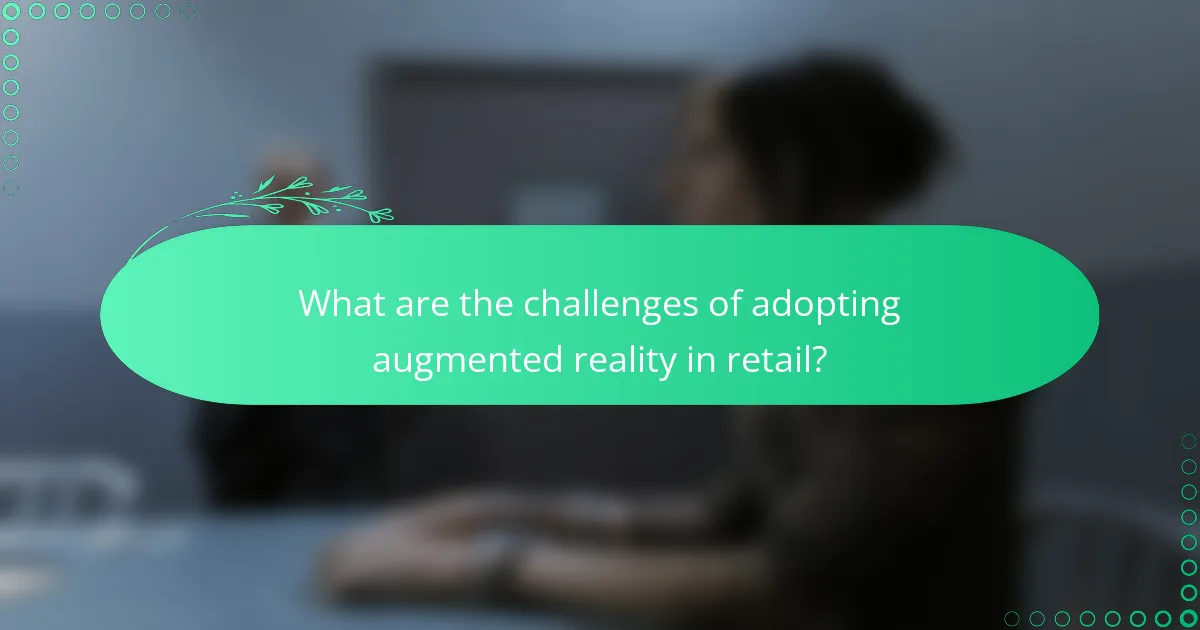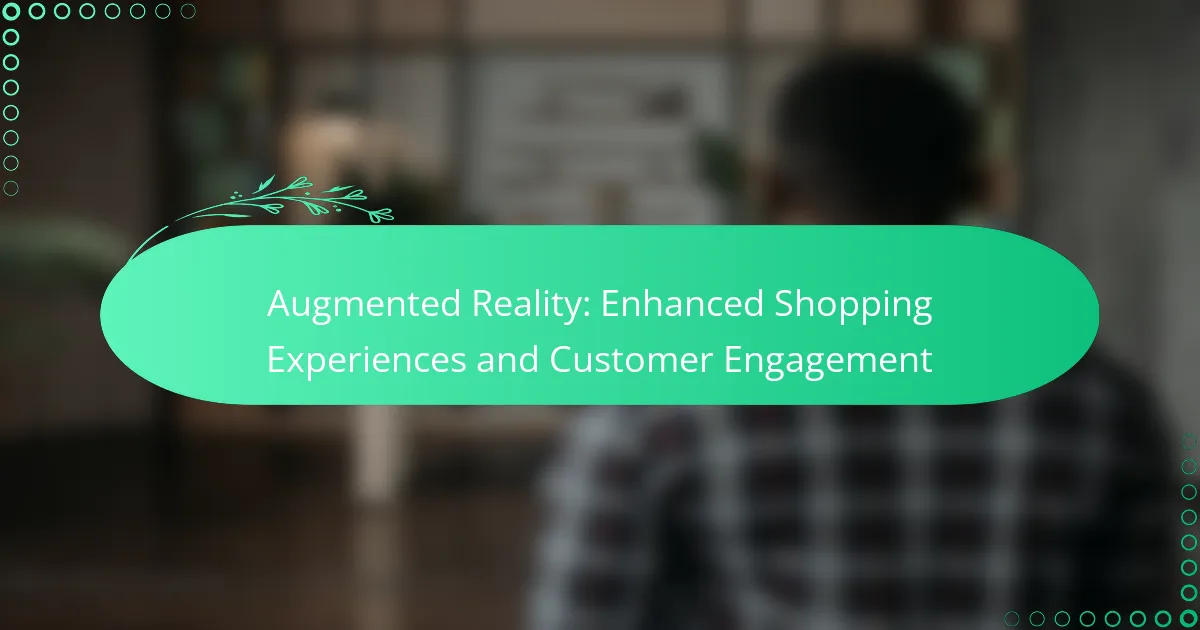Augmented reality (AR) is revolutionizing the shopping experience by enabling customers to visualize products in their own environments before making a purchase. This innovative technology enhances customer engagement through immersive interactions, bridging the gap between online and in-store shopping, and ultimately leading to increased satisfaction and personalization in the retail experience.

How does augmented reality enhance shopping experiences in retail?
Augmented reality (AR) enhances shopping experiences by allowing customers to visualize products in their own environment before making a purchase. This technology bridges the gap between online and in-store shopping, providing interactive and immersive experiences that increase customer engagement and satisfaction.
Virtual try-ons with IKEA Place
IKEA Place utilizes augmented reality to enable customers to visualize furniture in their homes. By using a smartphone or tablet, users can scan their space and place 3D models of IKEA products to see how they fit and look in real-time. This feature helps customers make informed decisions and reduces the likelihood of returns.
To use IKEA Place effectively, ensure your device is compatible and has a good camera. Take the time to explore different furniture arrangements, as this can reveal new design possibilities. Remember that lighting and room dimensions can affect how the furniture appears, so consider these factors when trying out different items.
Interactive product displays with Sephora Virtual Artist
Sephora Virtual Artist employs augmented reality to create an interactive shopping experience where customers can try on makeup virtually. Users can upload their photos or use live video to see how different products, such as lipsticks and eyeshadows, look on their skin tone. This feature not only enhances customer engagement but also helps in discovering new products that suit individual preferences.
When using Sephora Virtual Artist, take advantage of the ability to save looks and share them with friends for feedback. Be mindful of the lighting conditions while trying on products, as this can influence color perception. Additionally, explore the option to purchase directly through the app for a seamless shopping experience.

What are the benefits of augmented reality for customer engagement?
Augmented reality (AR) enhances customer engagement by providing immersive experiences that allow consumers to interact with products in innovative ways. This technology not only boosts user interaction but also personalizes shopping, making the overall experience more enjoyable and effective.
Increased customer interaction through Snapchat filters
Snapchat filters leverage augmented reality to create engaging experiences that encourage user interaction. By allowing customers to try on virtual products, such as makeup or accessories, brands can enhance their visibility and appeal. This interactive approach often leads to increased sharing on social media, amplifying brand reach.
Brands can create custom filters that align with marketing campaigns, providing a fun way for users to engage with their products. This not only drives customer interaction but also fosters a sense of community among users who share their experiences online.
Personalized shopping experiences with Amazon AR View
Amazon’s AR View feature allows customers to visualize products in their own space before making a purchase. By using their smartphone cameras, shoppers can see how items like furniture or decor will look in their homes, leading to more informed buying decisions. This capability reduces uncertainty and enhances customer satisfaction.
To maximize the benefits of AR View, customers should ensure their devices are compatible and updated. Additionally, retailers can enhance this experience by offering detailed product information and user reviews, helping shoppers feel confident in their choices.

How can businesses implement augmented reality in their marketing strategies?
Businesses can implement augmented reality (AR) in their marketing strategies by integrating immersive experiences that enhance customer engagement and product interaction. This can be achieved through AR applications, social media campaigns, and in-store experiences that allow customers to visualize products in their own environments.
Using AR apps for product visualization
AR apps enable customers to visualize products in real-time within their own space, enhancing the shopping experience. For instance, furniture retailers like IKEA offer apps that let users place virtual furniture in their homes to see how it fits and looks.
When developing an AR app, businesses should focus on user-friendly interfaces and high-quality graphics to ensure a seamless experience. Testing the app with real users can provide valuable feedback and help refine the functionality before launch.
Integrating AR into social media campaigns
Integrating AR into social media campaigns can significantly boost engagement by allowing users to interact with products in a fun and innovative way. Brands can create AR filters or lenses on platforms like Instagram and Snapchat, enabling users to try on products virtually, such as makeup or eyewear.
To maximize impact, businesses should promote these AR features through targeted ads and encourage user-generated content. This not only increases visibility but also fosters a sense of community as customers share their experiences with the AR tools.

What are the challenges of adopting augmented reality in retail?
Adopting augmented reality (AR) in retail presents several challenges, primarily related to costs and technology. Retailers must navigate high development expenses and the limitations of existing AR hardware to effectively implement these innovative solutions.
High development costs for AR applications
The development of AR applications can be prohibitively expensive, often requiring significant investment in both technology and expertise. Costs can range from tens of thousands to millions of dollars, depending on the complexity of the application and the features desired.
Retailers should consider starting with simpler AR solutions, such as virtual try-ons or basic product visualizations, to minimize initial costs. Investing in scalable platforms can also help manage expenses as the technology evolves.
Technical limitations of AR hardware
Current AR hardware, including smartphones and smart glasses, often has limitations in processing power, battery life, and display quality. These constraints can affect the user experience, leading to lag or reduced visual fidelity during interactions.
Retailers should ensure that their AR applications are optimized for the most commonly used devices among their target audience. Regular updates and user feedback can help identify and address technical issues, enhancing overall engagement and satisfaction.

How does augmented reality compare to traditional shopping methods?
Augmented reality (AR) enhances shopping experiences by overlaying digital information onto the physical world, offering a more interactive and engaging alternative to traditional shopping methods. While traditional shopping relies on physical interaction with products, AR allows customers to visualize items in their own space, improving decision-making and satisfaction.
Enhanced convenience versus in-store experience
AR provides significant convenience by allowing customers to shop from anywhere, reducing the need to travel to physical stores. With AR applications, users can visualize products in their homes, try on clothes virtually, or see how furniture fits in their space, making the shopping process quicker and more efficient.
In contrast, the in-store experience offers tactile interaction and immediate gratification, as customers can physically touch and try products. However, AR can bridge this gap by providing detailed information and visualizations that enhance the shopping experience without the constraints of location.
Cost-effectiveness of AR marketing campaigns
AR marketing campaigns can be more cost-effective than traditional advertising methods, as they often require lower production costs and can reach a wider audience through digital platforms. Brands can create engaging AR experiences that resonate with consumers, leading to higher engagement rates and potentially increased sales.
However, businesses should consider the initial investment in AR technology and content creation. While the long-term benefits can outweigh these costs, companies must ensure that their AR campaigns are well-targeted and provide real value to customers to maximize their return on investment.

What are the future trends of augmented reality in shopping?
The future of augmented reality (AR) in shopping is characterized by its growing integration into various retail channels and enhanced customer engagement. As technology advances, AR is set to transform how consumers interact with products, making shopping more immersive and personalized.
Increased use of AR in mobile commerce
Mobile commerce is increasingly adopting augmented reality to enhance the shopping experience. Retailers are leveraging AR applications that allow customers to visualize products in their own environment before making a purchase, which can significantly reduce return rates.
For example, furniture retailers often provide AR tools that enable users to see how a piece of furniture would look in their home. This trend is expected to grow as more consumers use smartphones for shopping, making AR a vital component of mobile commerce strategies.
Integration of AI with AR for smarter shopping experiences
The integration of artificial intelligence (AI) with augmented reality is creating smarter shopping experiences that cater to individual preferences. AI algorithms can analyze user behavior and preferences, allowing AR applications to offer personalized recommendations and virtual try-ons.
For instance, beauty brands are utilizing AI-driven AR to let customers virtually try on makeup products. This combination not only enhances customer satisfaction but also drives sales by making the shopping process more engaging and tailored to each user.

How is augmented reality shaping consumer behavior in major cities?
Augmented reality (AR) is significantly influencing consumer behavior in major cities by enhancing shopping experiences and increasing customer engagement. By integrating digital elements into the physical shopping environment, AR allows consumers to visualize products in real-time, leading to more informed purchasing decisions.
Increased Engagement through Interactive Experiences
AR creates interactive shopping experiences that captivate consumers, making them more likely to engage with brands. For instance, customers can use AR apps to see how furniture looks in their homes before making a purchase, which can lead to higher satisfaction and reduced return rates.
Retailers in cities like New York and London are implementing AR features in their stores, allowing shoppers to try on clothes virtually or visualize makeup products on their skin. This level of interaction not only enhances the shopping experience but also fosters a deeper connection between the consumer and the brand.
Impact on Decision-Making and Purchases
AR influences consumer decision-making by providing additional information and context about products. Shoppers can access reviews, product details, and even tutorials through AR interfaces, which can sway their choices significantly.
For example, a customer might use an AR app to compare different models of a smartphone by overlaying specifications and reviews directly onto the physical products. This immediate access to information can lead to quicker purchasing decisions and increased sales for retailers.
Challenges and Considerations for Retailers
While AR offers numerous benefits, retailers must also navigate challenges such as technology costs and consumer privacy concerns. Implementing AR solutions can require significant investment in technology and training staff to assist customers effectively.
Additionally, retailers should be mindful of data privacy regulations, especially in major cities where consumer protection laws are stringent. Ensuring that AR applications comply with local regulations is crucial to maintaining customer trust and avoiding legal issues.
